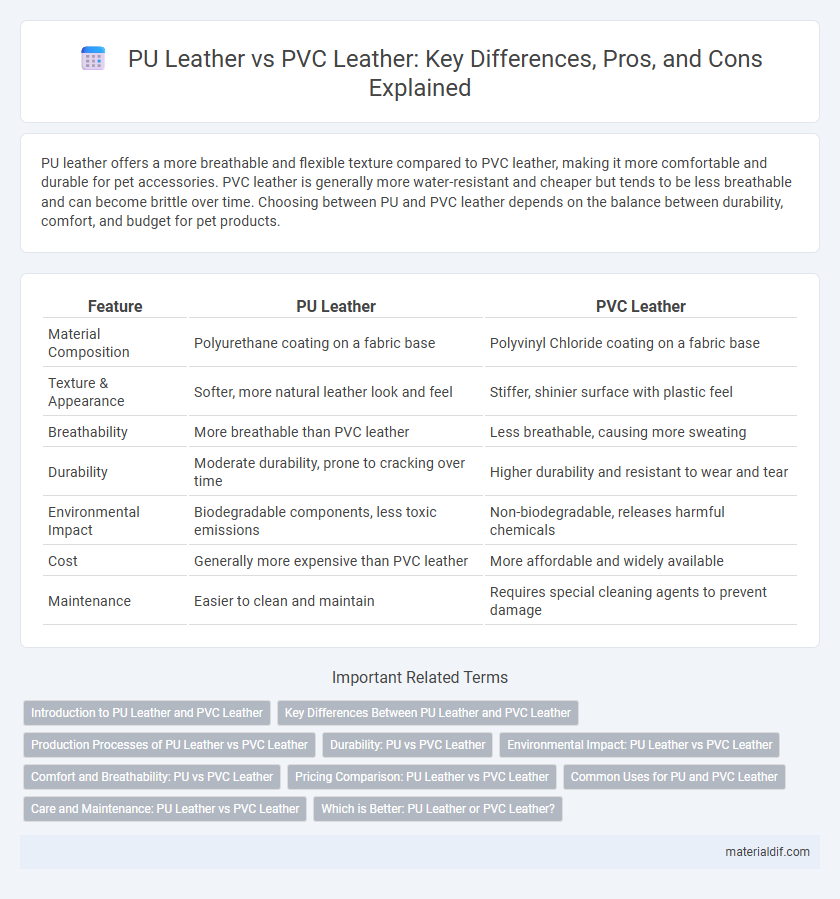PU leather offers a more breathable and flexible texture compared to PVC leather, making it more comfortable and durable for pet accessories. PVC leather is generally more water-resistant and cheaper but tends to be less breathable and can become brittle over time. Choosing between PU and PVC leather depends on the balance between durability, comfort, and budget for pet products.
Table of Comparison
| Feature | PU Leather | PVC Leather |
|---|---|---|
| Material Composition | Polyurethane coating on a fabric base | Polyvinyl Chloride coating on a fabric base |
| Texture & Appearance | Softer, more natural leather look and feel | Stiffer, shinier surface with plastic feel |
| Breathability | More breathable than PVC leather | Less breathable, causing more sweating |
| Durability | Moderate durability, prone to cracking over time | Higher durability and resistant to wear and tear |
| Environmental Impact | Biodegradable components, less toxic emissions | Non-biodegradable, releases harmful chemicals |
| Cost | Generally more expensive than PVC leather | More affordable and widely available |
| Maintenance | Easier to clean and maintain | Requires special cleaning agents to prevent damage |
Introduction to PU Leather and PVC Leather
PU leather, or polyurethane leather, is a synthetic material composed of a fabric base coated with a flexible polyurethane layer, offering a soft, breathable, and durable alternative to genuine leather. PVC leather, made from polyvinyl chloride, involves a plasticized vinyl coating on a textile backing, resulting in a more rigid, waterproof, and cost-effective material. Both PU and PVC leather serve as popular vegan leather options, with PU leather favored for its comfort and environmental advantages, while PVC leather is chosen for its resistance to moisture and ease of maintenance.
Key Differences Between PU Leather and PVC Leather
PU leather is made from a split leather base coated with a flexible polyurethane layer, offering a softer, more natural feel and greater breathability compared to PVC leather. PVC leather consists of a plasticized polyvinyl chloride coating on a fabric base, resulting in higher durability and water resistance but less flexibility and comfort. The environmental impact also differs, with PU leather being more biodegradable than the more chemically intensive PVC leather.
Production Processes of PU Leather vs PVC Leather
PU leather is produced through a coating process in which a polyurethane layer is applied to a fabric base, creating a flexible and breathable synthetic leather that mimics the texture of genuine leather. PVC leather is made by applying a polyvinyl chloride layer to a textile substrate, often involving plasticizers to increase flexibility, resulting in a more rigid and less breathable material. The production of PU leather generally involves fewer harmful chemicals and emissions compared to PVC leather, making it a more environmentally friendly alternative in synthetic leather manufacturing.
Durability: PU vs PVC Leather
PU leather offers superior durability compared to PVC leather due to its elastic and breathable polyurethane coating that resists cracking and peeling over time. PVC leather is less flexible and tends to become brittle, making it more prone to damage under heavy use or prolonged exposure to heat and sunlight. The enhanced wear resistance of PU leather makes it ideal for high-traffic applications and products requiring long-lasting performance.
Environmental Impact: PU Leather vs PVC Leather
PU leather generally has a lower environmental impact than PVC leather due to its biodegradability and the absence of chlorine in its production, which reduces toxic emissions. PVC leather manufacturing releases harmful dioxins and uses plasticizers that can leach into ecosystems, causing pollution and health risks. Sustainable PU leather options increasingly incorporate water-based adhesives and bio-based polyurethanes, further minimizing ecological harm compared to conventional PVC leather.
Comfort and Breathability: PU vs PVC Leather
PU leather offers superior comfort and breathability compared to PVC leather due to its polyurethane-based composition, which allows better air circulation and moisture absorption. PVC leather tends to be stiffer and less breathable as it is made from polyvinyl chloride, trapping heat and moisture against the skin. As a result, PU leather is often preferred for clothing and upholstery where prolonged wear and comfort are essential.
Pricing Comparison: PU Leather vs PVC Leather
PU leather generally costs more than PVC leather due to its more complex manufacturing process and closer resemblance to genuine leather. PVC leather is priced lower because it is made from vinyl, which is cheaper and easier to produce at scale. Buyers often choose PU leather for mid-range products seeking durability and appearance, while PVC leather suits budget-friendly options with less emphasis on texture and breathability.
Common Uses for PU and PVC Leather
PU leather is commonly used in the fashion industry for making clothing, shoes, and accessories due to its softness and flexibility. PVC leather finds frequent application in upholstery, automotive interiors, and outdoor furniture because of its durability and water resistance. Both materials serve as cost-effective alternatives to genuine leather in various consumer goods and industrial applications.
Care and Maintenance: PU Leather vs PVC Leather
PU leather requires gentle cleaning with a damp cloth and mild soap to maintain its softness and prevent cracking, while PVC leather is more resistant to water and can be cleaned with household cleaners without damage. PU leather benefits from occasional conditioning to retain flexibility, whereas PVC leather needs minimal maintenance but can become brittle over time if exposed to direct sunlight. Proper care extends the lifespan of both materials, with PU leather demanding more attention to avoid wear and tear compared to the more durable, low-maintenance PVC leather.
Which is Better: PU Leather or PVC Leather?
PU leather offers a more breathable and flexible texture compared to PVC leather, making it closer to genuine leather in appearance and comfort. PVC leather is known for its superior durability and water resistance, often used in heavy-duty applications where longevity is critical. Choosing between PU and PVC leather depends on whether comfort and breathability or durability and waterproof qualities are the priority.
PU leather vs PVC leather Infographic

 materialdif.com
materialdif.com